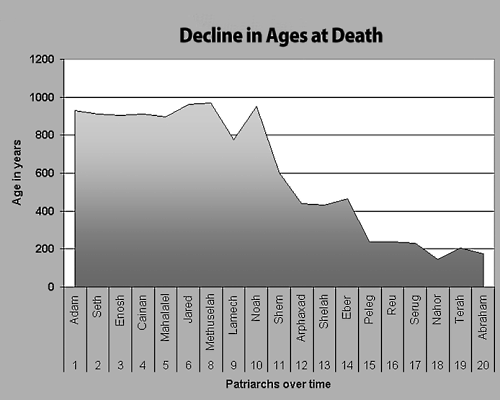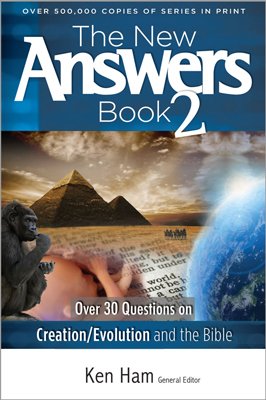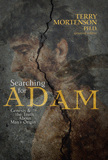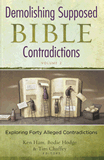
Chapter 13
Ancient Biblical Lifespans: Did Adam Live Over 900 Years?
Exploring how Adam, Methuselah, and Noah in the book of Genesis really lived for centuries and biological/genetic reasons why humans no longer live that long.
The Bible teaches quite plainly that the early patriarchs often lived to be nearly 1,000 years old and even had children when they were several hundred years old!
“Methuseleh lived 900 years . . . but these stories you’re liable to read in the Bible, they ain’t necessarily so.”1
Along with American composer George Gershwin, many people find it difficult to believe that Methuselah lived to be 969 years old. Nevertheless, the Bible teaches quite plainly that the early patriarchs often lived to be nearly 1,000 years old and even had children when they were several hundred years old! Similar claims of long life spans are found in the secular literature of several ancient cultures (including the Babylonians, Greeks, Romans, Indians, and Chinese). But even a life span of nearly 1,000 years is sadly abbreviated when we consider that God initially created us to live forever.
According to the Bible, God created the first humans—Adam and Eve—without sin and with the ability to live forever. God gave the first human couple everything they needed for their eternal health and happiness in the Garden of Eden; but He warned them not to eat fruit from the Tree of the Knowledge of Good and Evil or they would die, as indeed would all their descendants after them (Genesis 2:16–17). When Satan’s deception prompted Eve to disobey this command and then Adam willfully disobeyed, their minds and bodies profoundly changed (Genesis 3). Not only did they become subject to death, but their firstborn son (Cain) became the world’s first murderer. Truly, the wages of sin is death, physically and spiritually. It is sobering to think that the Bible would have been only a few pages long—from creation to the fall into sin—were it not for the undeserved love of God who both promised and sent the Messiah to save us from sin and death (Genesis 3:15; Isaiah 25:8; Psalm 49:14–15; 1 John 5:13).
For 1,500 years after creation, men lived such long lives that most were either contemporaries of the first man, Adam, or personally knew someone who was! The ten patriarchs (excluding Enoch) who preceded the Great Flood lived an average of 912 years. Lamech died the youngest at the age of 777, and Methuselah lived to be the oldest at 969. See table 1.
| Patriarch | Age | Bible Reference | |
|---|---|---|---|
| 1 | Adam | 930 | Genesis 5:5 |
| 2 | Seth | 912 | Genesis 5:8 |
| 3 | Enosh | 905 | Genesis 5:11 |
| 4 | Cainan | 910 | Genesis 5:14 |
| 5 | Mahalalel | 895 | Genesis 5:17 |
| 6 | Jared | 962 | Genesis 5:20 |
| 7 | Enoch | 365 (translated) | Genesis 5:23 |
| 8 | Methuselah | 969 | Genesis 5:27 |
| 9 | Lamech | 777 | Genesis 5:31 |
| 10 | Noah | 950 | Genesis 9:29 |
During the 1,000 years following the Flood, however, the Bible records a progressive decline in the life span of the patriarchs, from Noah, who lived to be 950 years old, until Abraham at 175 (see figure 1 and table 2). In fact, Moses was unusually old for his time (120 years) because, when he reflected on the brevity of life, he said: “The days of our lives are seventy years; and if by reason of strength they are eighty years, yet their boast is only labor and sorrow; for it is soon cut off, and we fly away” (Psalm 90:10).
| Patriarch | Age | Bible Reference | |
|---|---|---|---|
| 11 | Shem | 600 | Genesis 11:10–11 |
| 12 | Arphaxad | 438 | Genesis 11:12–13 |
| 13 | Shelah | 433 | Genesis 11:14–15 |
| 14 | Eber | 464 | Genesis 11:16–17 |
| 15 | Peleg | 239 | Genesis 11:18–19 |
| 16 | Reu | 239 | Genesis 11:20–21 |
| 17 | Serug | 230 | Genesis 11:22–23 |
| 18 | Nahor | 148 | Genesis 11:24–25 |
| 19 | Terah | 205 | Genesis 11:32 |
| 20 | Abraham | 175 | Genesis 25:7 |
Extrabiblical evidence to support the long life spans of the people in Genesis is found in the Sumerian King List. This list mentions a flood and gives the length of the reigns of kings before and after a flood. There are many striking parallels between the Sumerian King List and Genesis, such as a flood event, numerical parallels between the pre-Flood biblical patriarchs and the antediluvial kings, and a substantial decrease in life span of people following the flood.2 One author on this subject concludes, “It is highly unlikely that the biblical account was derived from the Sumerian in view of the differences of the two accounts, and the obvious superiority of the Genesis record both in numerical precision, realism, completion, and moral and spiritual qualities.”2 It is more likely that the Sumerian King List was composed using Genesis for numerical information. Obviously, the Book of Genesis would only be used if the person writing the list believed it to be a true historical account containing accurate information.

Today, man’s maximum life span is about 120 years,3 and our average life expectancy is still only 70–80 years—just as it was when the 90th Psalm was written 3,400 years ago! The precipitous plunge in life spans after the Flood suggests that something changed at the time of the Flood, or shortly thereafter, that was responsible for this decline. A line graph of this decline reveals an exponential curve (see figure 1). An exponential decay rate is often called a “natural” decay rate because it is so often observed in nature. For example, this is the decay curve we see when living organisms are exposed to lethal doses of toxic substances or radiations. Since it is unlikely that people living in pre-Flood times were familiar with exponential decay curves, it is thus unlikely that these dates were fabricated.
The fossil record reveals that prior to the Flood, most of the earth appears to have had a tropical type of environment. Following the Flood, there was clearly an environmental change resulting in an ice age that covered nearly 30 percent of the earth with ice (primarily in the northern latitudes). This, together with other changes following the Flood, could have adversely affected life spans.
Biological Causes of Aging
What exactly causes this process of aging in our body? Although the mechanism of aging (and its prevention) has long been an object of biomedical research, science still has no definitive answer to this question. Around the turn of the century, it was believed that aging didn’t directly involve the living cells of our body but rather was an extracellular phenomenon. It was believed that our normal living cells, if properly nourished, could grow and divide indefinitely outside our body. In 1961, this idea was refuted by Leonard Hayflick, who grew human cells outside the body in covered glass dishes containing the necessary nutrients. Hayflick discovered that cells cultured in this way normally died after about 50 cell divisions (Hayflick’s limit). This suggests that even the individual cells of our body are mortal, apart from any other bodily influence.
Genetic Determinants
Both aging and life span are processes that have genetic determinants that are overlapping and unique. Approximately 20–30 percent of factors affecting life span are thought to be heritable and thus genetic.4 Life span varies greatly among individuals, indicating that while aging plays a role, other factors are also involved.
Mutations and Genetic Bottlenecks
A mutation is any change in the sequence of DNA.5 All known mutations cause a loss of information. The rate at which all types of mutations occur per generation has been suggested to be greater than 1,000.6 We inherit mutations from our parents and also develop mutations of our own; subsequently, we pass a proportion of those on to our children. So it is conceivable in the many generations between Adam and Moses that a large number of mutations would have been present in any given individual.
Genetic bottlenecks (or population bottlenecks) occur when a significant proportion of the population dies or proportions become isolated. Such a bottleneck occurred at the time of Noah’s flood when the human population was reduced to eight people (Genesis 6–9). Other smaller bottlenecks occurred following the Tower of Babel dispersion (Genesis 11). These events would have resulted in a major reduction of genetic variety.
For every gene there are two or more versions called alleles. This is analogous to the color red (gene) but different shades of red—light and dark (alleles). It is possible for “good” (unmutated) alleles to mask or hide “bad” (mutated) alleles. However, in a smaller population with less allelic variation, this becomes more difficult to accomplish, and thus mutated alleles have a greater effect.
Although Noah lived 950 years, his father, Lamech, lived only 777 years (granted we do not know if he died from old age). In addition, we do not know how long Noah’s wife lived, but Noah’s son Shem only lived 600 years. Considering that the longest recorded life span of someone born after the Flood was Eber at 464 years, it would appear that both mutations and genetic bottlenecks had severe effects on aging and life span.
Examples of Genetic Determinants Affecting Aging and Life Span
Although many genetic factors are suggested to affect aging and life span, these processes largely remain a mystery. Aging can be thought of as increased susceptibility to internal (i.e., agents that damage DNA) and external (i.e., disease-causing bacteria) stressors because of a decrease in the maintenance, repair, and defensive systems of the body.
For example, DNA repair systems are needed to protect the genome (all our DNA) from mutation. Xeroderma pigmentosum (XP) is a genetic disorder caused by a deficient (due to mutations) DNA repair system that normally repairs mutations caused by ultraviolet light. Individuals with this disease must severely limit their exposure to sunlight. Outer surfaces of the body, such as skin and lips, commonly show signs of premature aging.7 While this is an extreme example, any mutation that decreases the efficiency of our maintenance, repair, and defensive systems will likely lead to more rapid aging and decreased life span.
Telomeres, long, repetitive sequences of DNA at the ends of human chromosomes, are also thought to play an important role in aging. With each division of the cell, telomeres shorten due to the inability of the enzyme that copies the DNA to go all the way to the end of the chromosome.8 When telomeres have become too short, the cell stops dividing. This limitation plausibly serves as a quality control mechanism. Older cells will have accumulated many mutations in their DNA, and their continued division may lead to diseases like cancer. Most body cells cannot replicate indefinitely, leading to aging and eventually death. Thus, telomeres are important in determining the life span of cell types that directly affect aging.

Genetic determinants of life span or longevity are difficult to pinpoint. Even if the genes are determined to be associated with people who live for many years, their actual role in increasing life span is unknown. Genetic studies of centenarians (people who have lived more than 100 years) have produced several possible candidate longevity genes. The gene for apolipoprotein E (APOE), important in the regulation of cholesterol, has certain alleles that are more common among centenarians.9 This is also true for certain alleles of insulin-like growth factor 1 (IGF1), important in cell proliferation and cell death, and superoxide dismutases (SOD), important in the breakdown of agents that damage DNA.9 Possibly the alleles associated with the centenarians more closely reflect the genetic makeup of individuals with a long life span 6,000 years ago. Still, these alleles show the effects of the curse if the highest achievable age today is around 120 years!
Evolution and the Genetics of Aging and Life Span
Evolution has a difficult time explaining aging and life span. Aging is often viewed as a default. Genes are selected on the basis of how they benefit an individual in their young reproductive years, or the “ ‘warranty period’ [which] is the time required to fulfill the Darwinian purpose of life in terms of successful reproduction for the continuation of generations.”10 However, these same genes may be harmful overall, leading to aging and eventually death.
The problem for evolution is that longevity genes are selected for. To deal with this seeming dichotomy, some evolutionists have suggested that selection of longevity genes serves a purpose in that long-lived individuals can care for more of their descendants, known as the “grandmother effect.”11 The problem is that any theory that is so flexible it can account for everything isn’t a very good theory.
Genes associated with aging and life span have been affected as a result of the fall either directly through mutations or indirectly through genetic bottlenecks. Modern medicine and anti-aging therapies may slow the process of aging and extend our life span, but they will never eradicate the ultimate end—death. Only Jesus Christ, who was victorious over death, can promise eternal life with Him to all who believe (Romans 6:23, 10:9).
Physiological Determinants
In one sense, most of the substance of our body really doesn’t continue to get older during our life: a great many of our body’s parts are constantly repairing and replacing themselves. The epidermal cells that cover the entire surface of our skin, for example, never get older than one month. New cells are continually produced (by cell division) deep in the epidermis, while the older ones continually slough off at the surface. Similarly, the cells lining our intestines completely replace themselves every 4 days; our red blood cells are entirely replaced about every 90 days; and our white blood cells are replaced about every week.
Even cells that never (or rarely) divide, such as cardiac muscle cells and brain cells, turn over molecule by molecule. It is believed that little or nothing in our body is more than about 10 years old. Thus, thanks to cell turnover and replacement, most of the organs in the body of a 90-year-old man are perhaps no older than those of a child. Indeed, you might say our body never actually grows older.
It’s rather like the story about “grandpa’s ax.” It seems a man had an old ax that hung over his fireplace and which he claimed had been passed down in his family for five generations. When asked how old the ax was, he said he wasn’t sure because although his great-great-great-great grandfather bought the ax about 300 years ago, he also understood that over the years, the ax had 6 new heads and 12 new handles. Our bodies are something like grandpa’s ax in that we too are constantly replacing “heads and handles,” and in a sense we never get older.
Is it even possible for anyone to age and die if the body constantly repairs and replaces its parts?
At this point we might be inclined to ask, why did Methuselah die so young? How, indeed, is it even possible for anyone to age and die if the body constantly repairs and replaces its parts? Surely, if our automobile could do this, we would expect it to last forever. Part of the answer may be that certain key parts of our body fail to repair or replace themselves. Our critically important heart muscle cells, for example, fail to multiply, repair, or replace themselves after birth (although, like all muscle cells, they can increase in size). This is why any disruption in the blood supply to the heart muscle during a heart attack leads to permanent death of that part of the heart. Most nerve cells of our brain—including those of our eye and inner ear—also fail to multiply or repair themselves. From the time of our birth to the end of our life, we lose thousands of nerve cells a minute from our central nervous system, and we can never replace them. As we get older, this causes a progressive loss of our ability to hear, see, smell, taste, and . . . ahh . . . something else, but I just can’t remember it!
The important point is that science offers no hope for eternal life, or even for the significant lengthening of life. It has been estimated that if complete cures, or preventions, were found for the three major killers (cancer, stroke, and coronary artery disease), the maximum life span of man would still not increase (although more people would approach this maximum). And such long-lived people would still become progressively weaker with age as critical components of their body continued to deteriorate.
We may conclude that God’s Word, not science, has the complete solution to the problem of aging and death. The solution has been “revealed by the appearing of our Savior Jesus Christ, who has abolished death and brought life and immortality to light through the gospel” (2 Timothy 1:10).
The New Answers Book 2
In The New Answers Book 2 you’ll find 31 more great answers to big questions for the Christian life.
Read Online Buy BookFootnotes
- George Gershwin, “It Ain't Necessarily So,” Porgy & Bess, 1934.
- Raul Lopez, “The Antediluvian Patriarchs and the Sumerian King List,” CEN Technical Journal 12, no. 3 (1998): p. 347–357.
- It should be noted that Genesis 6:3 does not refer to God mandating a maximum life span for people of 120 years. If this is the case, then the Bible is in error as many people have been recorded as living longer than 120 years. Rather, it refers to the amount of time from when God determined to destroy mankind to when God sent a global flood.
- T. Perls and D. Terry, “Genetics of Exceptional Longevity,” Experimental Gerontology 38 (2003): 725–730.
- See chapter 7, which provides an overview of mutations.
- J. Sanford, Genetic Entropy and the Mystery of the Genome (New York: Ivan Press, 2005), p. 37.
- DermNet NZ, “Xeroderma pigmentosum,” www.dermnetnz.org/systemic/xeroderma-pigmentosum.html.
- P. Monaghan and M. Haussmann, “Do Telomere Dynamics Link Lifestyle and Lifespan?” TRENDS in Ecology and Evolution 21 (2006): 47–53.
- K. Christensen et al., “The Quest for Genetic Determinants of Human Longevity: Challenges and Insights,” Nature Reviews Genetics 7 (2006): 436–448.
- S. Rattan, “Theories of Biological Aging: Genes, Proteins, and Free Radicals,” Free Radical Research 41 (2006): 1230–1238.
- W. Browner et al., “The Genetics of Human Longevity,” The American Journal of Medicine 11 (2004): 851–860.
Recommended Resources

Answers in Genesis is an apologetics ministry, dedicated to helping Christians defend their faith and proclaim the good news of Jesus Christ.
- Customer Service 800.778.3390
- © 2024 Answers in Genesis





